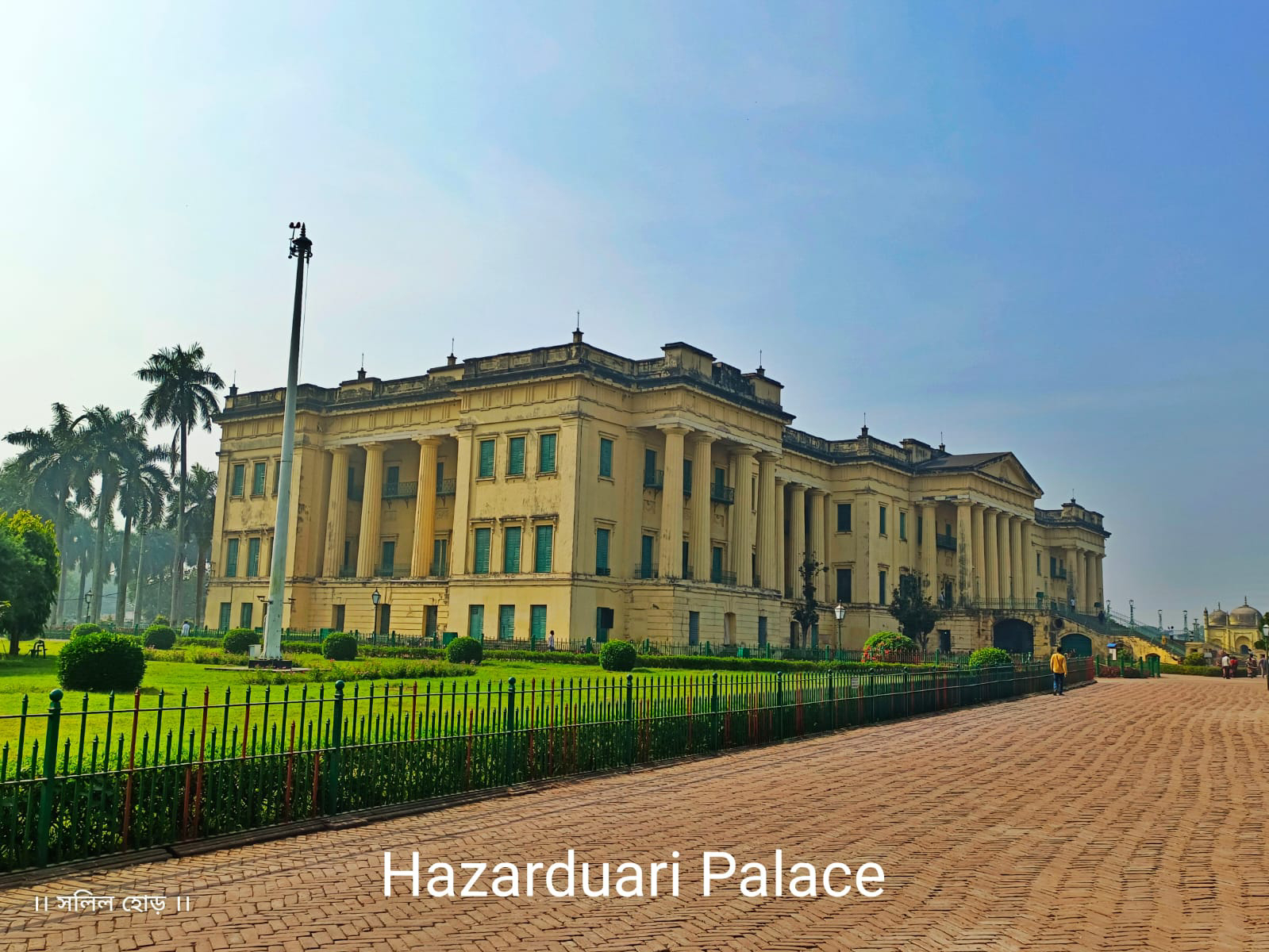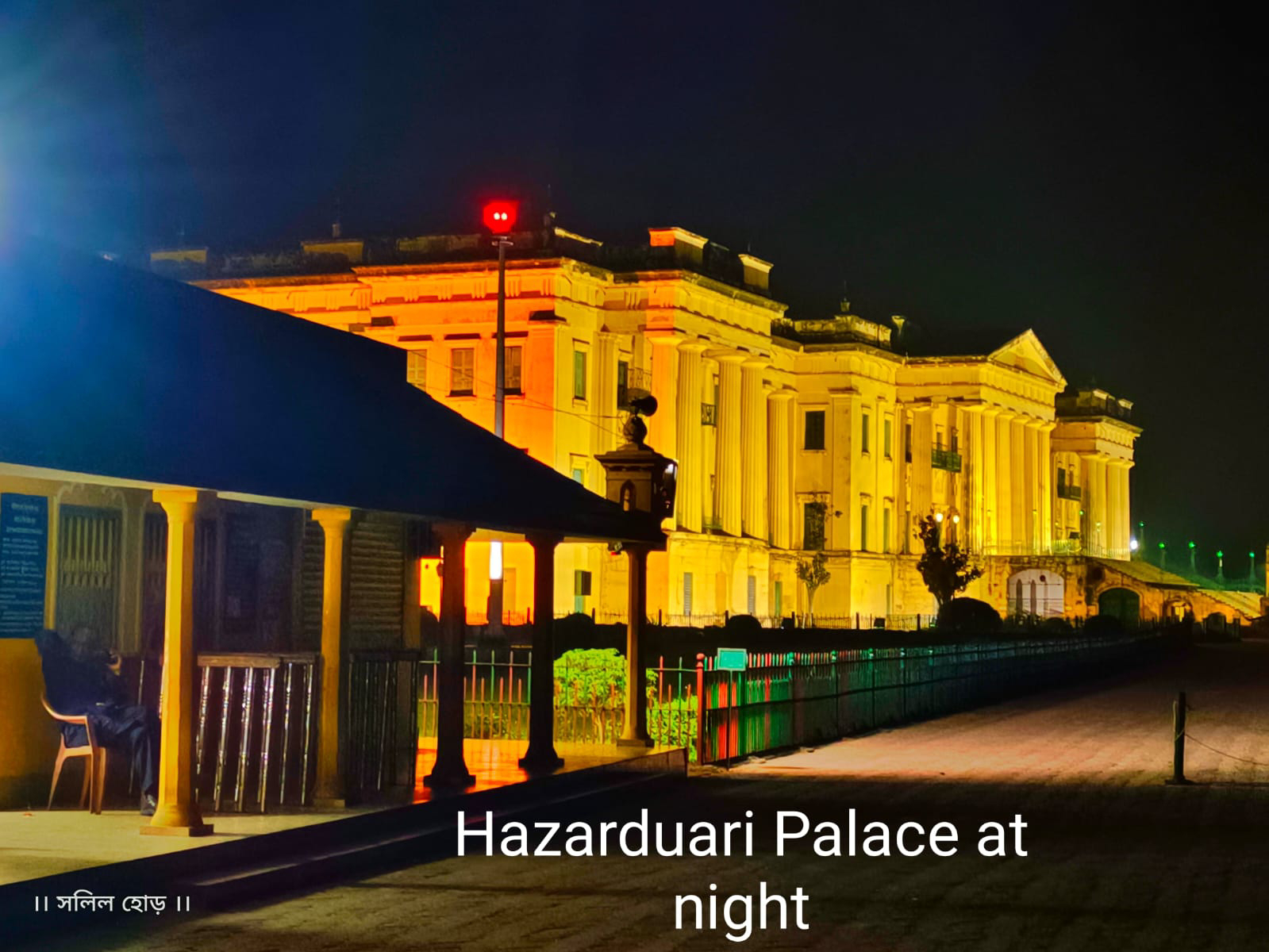হাজারদুয়ারি প্রাসাদ এবং তার প্রাঙ্গণে কয়েকটি দ্রষ্টব্য, মুর্শিদাবাদ (Hazarduari Palace and its Surroundings: Must-See Sights in Murshidabad)
মুর্শিদাবাদ জেলার হাজারদুয়ারি প্রাসাদ হলো মুর্শিদাবাদের শ্রেষ্ঠ আকর্ষণ। এই হাজারদুয়ারির আকর্ষণেই মুর্শিদাবাদে প্রতি বছর লক্ষ লক্ষ পর্যটক আসেন। তবে একটা বিরাট সংখ্যক মানুষের ধারণা, এটা বানিয়েছেন নবাব সিরাউদ্দৌলা। কিন্তু বাস্তবে, সিরাজের মৃত্যুর অনেক পর এটা বানানো হয়েছে। এটি বানিয়েছিলেন তৎকালীন নবাব নাজিম হুমায়ূন জা। বেঙ্গল ইঞ্জিনিয়ার্সের স্থপতি কর্নেল ডানকান ম্যাকলিওড, ইটালিয়ান ধাঁচে এই প্রাসাদটি তৈরী করেন।
প্রাসাদের ভিত্তিপ্রস্তর স্থাপিত হয় ১৯২৯ খ্রিস্টাব্দের ২৯ শে আগস্ট, এবং কাজ সম্পুর্ণ হয় ১৮৩৭ খ্রিস্টাব্দে। ৮০ ফিট উঁচু, দৈর্ঘ্যে ৪২৫ ফিট ও প্রস্থে ২০০ ফিট, তিনতলা এই প্রাসাদের নির্মাণকার্যে খরচ হয়েছিল প্রায় সাড়ে ষোলো লক্ষ টাকা। চুন সুরকির গাঁথনিতে ব্যবহার করা হয়েছিল প্রচুর পরিমাণে ডিমের কুসুম, মৌরী ভেজানো জল এবং খয়ের জল। প্রাসাদের প্রধান প্রবেশদ্বারের সামনে রয়েছে কালো ব্যাসল্ট পাথরের প্রশস্ত সিঁড়ি, এবং সিঁড়ির দুই পাশে রয়েছে সিংহের মূর্তি। সিংহের মূর্তির পাশে রয়েছে মাঝারি আকৃতির কামান।
এই প্রাসাদটি বানানোর মূল উদ্দেশ্য ছিল দরবার পরিচালনা এবং ইউরোপীয় বিশিষ্ট অতিথিবর্গের অভ্যর্থনা ও বিনোদনের ব্যবস্থা করা। সেই কারণে, প্রাসাদের সবচেয়ে আকর্ষণীয় দ্রষ্টব্য এর সুদৃশ্য দরবার কক্ষ। এখানে এই কক্ষের শীর্ষে এমনভাবে কাচ বসানো রয়েছে যে, সবসময়েই এই দরবায় কক্ষটি আলোকিত থাকে। সবথেকে আকর্ষণীয় জিনিস দরবার কক্ষের মাঝখানে ১০১ বাতির একটি সুদৃশ্য ঝাড়লন্ঠন, যা রানী ভিক্টোরিয়া উপহার দিয়েছিলেন।
বর্তমানে এই প্রাসাদের একতলায় রয়েছে অফিসঘর, রেকর্ড ঘর ও অস্ত্রাগার, যেখানে এই প্রচুর অস্ত্রশস্ত্র সংগ্রহ করে রাখা হয়েছে। পলাশির যুদ্ধে ব্যবহৃত মীরমদনের কামান আজও সেখানে রাখা আছে। এছাড়া আছে মীরকাশিমের ছোরা, আলিবর্দি ও সিরাজের তরবারি, নাদিরশাহের বল্পম ও শিরন্ত্রাণ। তাছাড়া রয়েছে মীরকাশিমের মুঙ্গের কারখানায় তৈরি বন্দুক।
দোতলায় রয়েছে আর্ট গ্যালারী ও লাইব্রেরী | বিভিন্ন বিষয় ও বিভিন্ন ভাষায় লিখিত প্রায় ১২,০০০ পুস্তক এখানে সংরক্ষিত আছে। এছাড়াও আছে বহু দুর্মূল্য, পাণ্ডুলিপি; হারুণ অল রসিদের হস্তলিখিত বত্রিশ পাতার কোরাণ; আবুল ফজলের 'আইন ই আকবরী'-এর পাণ্ডুলিপি এখানে রাখা আছে। এছাড়াও আছে আর আছে রাফায়েল, ভ্যানডিউক, টিশিয়ান, জর্জ, মার্শাল ও অজ্ঞাতনামা বহু শিল্পীর চিত্রকলা। তাছাড়া এখানে রয়েছে সিরাজের ব্যবহৃত রূপোর সিংহাসন, মুর্শিদকুলি খাঁর মার্বেল পাথরের সিংহাসন; রয়েছে প্রচুর পানপাত্র, চীনামাটির ফুলদানি, নবাবী আসবাব, হাতির দাঁতের সোফাসেট, বিষ পরীক্ষা করার প্লেট, স্টাফ করা দুষ্প্রাপ্য পাখী, বিলিয়ার্ড বোর্ড, হারেমের মহিলাদের হস্তশিল্প, রকমারী ঘড়ি, ম্যাজিক আয়না, দামী পাথরের বিভিন্ন মুর্তি। তবে গ্রস্থাগ্রারটি জনসাধারণকে দেখতে দেওয়া হয় না, এটি দেখতে গেলে বিশেষ অনুমতির প্রয়োজন।
হাজারদুয়ারি প্রাসাদ প্রতি শুক্রবার বন্ধ থাকে, ১৫ বৎসর পর্যন্ত কোন টিকিট লাগে না। হাজারদুয়ারি ক্যাম্পাসে খুব সুন্দর বাগান আছে, আর তার চারপাশে লাল সুড়কির রাস্তা। সম্প্রতি আর্কিওলজিক্যাল সার্ভের উদ্যোগে এর সৌন্দর্য বহগুণে বৃদ্ধি পেয়েছে।
হাজারদুয়ারির বাগানটির মধ্যে আরও কয়েকটি দ্রষ্টব্য রয়েছে। সেগুলো এই ব্লগে আমি ছুঁয়ে যাবো।
ঘড়ি মিনার:
হাজারদুয়ারি প্রাসাদের স্থপতি কর্নেল ম্যাকলিওডের বাঙালি সহকারী সাগর মিস্ত্রি, এই মিনারটি নির্মাণ করেন। মিনারের চারদিকে চারটি সিংহমূর্তি ঢাল নিয়ে বসে আছে। ঘড়ির ডায়ালটি রয়েছে ভাগীরথী নদীর দিকে মুখ করে, যাতে নৌকাযাত্রীরা এবং জাহাজের নাবিকরা দিকনির্দেশ পেতে পারেন, সাথে সময়ও দেখতে পারেন।
ঘড়িটি বহুকাল বন্ধ থাকার পরে, বর্তমানে আবার মেরামত করে চালু করা হয়েছে।
বাচ্চোওয়ালী তোপ:
বাগানে একটা বেদীর ওপর একটি বিশাল কামান দেখতে পাওয়া যায়; এরই নাম বাচ্চোওয়ালী তোপ। কামানটি কে বানিয়েছিলেন এবং কবে, সেই বিষয়ে বিশেষ জানা যায় না। এটা একবার দাগতে ১৮ কেজি মশলা বা বারুদের দরকায় হত। অবশ্য এটা একবারই দাগা হয়েছিল। সেই কামানের আওয়াজের তীব্রতা এত বেশী ছিল যে সে সময় বহু গর্ভবতী মহিলার গর্ভপাত ঘটে, এবং কামানটির নাম হয়ে যায় 'বাচ্চোওয়ালী তোপ'।
নৌকাপথে নবাবের কাছে পাঠানোর সময় এটি নৌকাডুবি হয় (সময়টি অজানা)। নবাব হুমায়ূন জার আমলে এটি গঙ্গাগর্ভ থেকে উদ্ধার করা হয়, এবং তারপর থেকেই হাজারদুয়ারির মাঠে রাখা আছে।
সিরাজের মদিনা:
হাজারদুয়ারি প্রাঙ্গণে একটা সময়ে ছিল সিরাজের তৈরী একটি কাঠের ইমামবাড়া। সেই ইমামবাড়ার মাঝে ছিল একটি মদিনা, যেটি চুন সুড়কির বানানো। এই মদিনা তৈরির সময় পবিত্র মক্কা মদিনার মাটি আনিয়ে প্রথমে ত্রিপোলিয়া গেটের কাছে নৌসেরী বানুর সমাধি মসজিদে রাখা হয়। পরে সিরাজ স্বয়ং খালি পায়ে মাথায় করে সেই পবিত্র মাটি নিয়ে মদিনার ভিত্তি স্থাপনের সময় দেন।
এই মদিনার দরজায় ছিল মহামূল্যবান রত্ন। মীরকাশিম যখন রাজধানী মুর্শিদাবাদ থেকে সরিয়ে মুঙ্গেরে নিয়ে যান, তখন দরজা থেকে তুলে নেন সেগুলি। 'রিয়াজ-উস-সালাতিন' গ্রন্থে এই মদিনার প্রশংসা করা হয়েছে। মদিনাটি অষ্টাদশ শতকের মুসলিম স্থাপত্যের এক উজ্জ্বল নির্দশন।
হলুদ মসজিদ:
হাজারদুয়ারির বামদিকে একটি মাঝারি আকৃতির হলুদ রঙের মসজিদ রয়েছে, যার পোশাকি নাম জুরুদ মসজিদ হলেও, লোকমুখে হলুদ মসজিদ নামেই পরিচিত। মসজিদের স্থাপনার সময় মোটামুটি অষ্টাদশ শতকের মাঝামাঝি কিংবা শেষের দিকে। তবে কে এই মসজিদের স্থাপনা করেছেন, সেটা নিয়ে ঐতিহাসিকদের মধ্যে মতবিরোধ রয়েছে। কেউ বলেন এটা নবাব সিরাজদ্দৌলার তৈরী, আবার কেউ বলেন নবাবদের অত্যাচারে স্থানীয় লোকজন কয়েকজন ধনী মুসলমান ব্যক্তির সাহায্য নিয়ে এই মসজিদ তৈরী করিয়েছেন।
তবে মসজিদটি প্রায় ধ্বংস হয়ে গিয়েছিল। ASI থেকে এটি সংরক্ষণ করে, মসজিদটি আবার গড়ে তোলা হয়। তাই কোনো প্রতিষ্ঠাফলক আর পাওয়া যায় না। বর্তমানে, এখানে শুধু নামাজিরাই প্রবেশ করতে পারেন।
(English Version)
Hazarduari Palace and its Surroundings: Must-See Sights in Murshidabad
The Hazarduari Palace in the Murshidabad district is Murshidabad's premier attraction. Millions of tourists visit Murshidabad annually, drawn by the allure of Hazarduari. However, a large number of people mistakenly believe it was built by Nawab Siraj-ud-Daulah. In reality, it was constructed long after Siraj's death by the then-Nawab Nazim Humayun Jah. Colonel Duncan Macleod of the Bengal Engineers designed this palace in the Italian style.
The palace's foundation stone was laid on August 29, 1829, and its construction was completed in 1837. This three-storied palace, standing 80 feet tall, 425 feet long, and 200 feet wide, cost approximately sixteen and a half lakh rupees to build. Its lime-surkhi masonry incorporated a significant amount of egg yolk, fennel-infused water, and catechu water. The main entrance of the palace features a grand staircase made of black basalt stone, flanked by lion statues and medium-sized cannons.
The primary purpose of building this palace was to conduct court proceedings and to host and entertain distinguished European guests. Consequently, the most captivating sight within the palace is its magnificent Durbar Hall. The hall's ceiling is fitted with glass in such a way that it remains illuminated at all times. The most striking feature in the center of the Durbar Hall is a beautiful 101-light chandelier, a gift from Queen Victoria.
Currently, the ground floor of the palace houses offices, a record room, and an armory with a vast collection of weapons. Mir Madan's cannon, used in the Battle of Plassey, is still preserved there. Additionally, you can find Mir Qasim's dagger, Alivardi and Siraj's swords, Nadir Shah's spear and helmet, and muskets manufactured in Mir Qasim's Munger factory.
The first floor (referred to as "Do-tala" or second floor in the original Bengali, but functionally the first floor in English architectural terms after the ground floor) features an art gallery and library. Approximately 12,000 books on various subjects and in different languages are preserved here. There are also numerous invaluable manuscripts, including a 32-page handwritten Quran by Harun al-Rashid and a manuscript of Abul Fazl's 'Ain-i-Akbari'. Furthermore, the gallery displays paintings by artists like Raphael, Van Dyck, Titian, George, Marshall, and many unnamed artists. Other notable items include Siraj's silver throne, Murshid Quli Khan's marble throne, numerous drinking vessels, porcelain vases, Nawabi furniture, an ivory sofa set, a poison-testing plate, stuffed rare birds, a billiard board, handicrafts by harem women, various clocks, a magic mirror, and various sculptures made of precious stones. However, the library is not open to the general public and requires special permission to view.
The Hazarduari Palace is closed every Friday. There is no entry fee for children up to 15 years of age. The Hazarduari campus boasts a beautiful garden surrounded by red gravel paths. Recently, its beauty has been significantly enhanced through initiatives by the Archaeological Survey of India.
The Hazarduari garden itself contains several other points of interest. I will touch upon them in this blog.
Clock Tower (Ghanta Ghar)
This tower was constructed by Sagar Mistry, the Bengali assistant to Colonel Macleod, the architect of Hazarduari Palace. Four lion statues, each holding a shield, are seated on all sides of the tower. The clock dial faces the Bhagirathi River, allowing boatmen and ship navigators to determine direction and time. After being non-functional for a long time, the clock has recently been repaired and is now operational again.
Bacchawali Tope
In the garden, on a raised platform, sits a massive cannon known as the Bacchawali Tope. Not much is known about who created this cannon or when. It required 18 kg of gunpowder for a single shot. Interestingly, it was only fired once. The intensity of the cannon's sound was so immense that it caused miscarriages in many pregnant women at the time, earning it the name 'Bacchawali Tope' (meaning "child-bearing cannon").
The cannon sank in a boating accident while being transported to the Nawab (the exact time is unknown). It was recovered from the Ganges during the reign of Nawab Humayun Jah and has been housed on the Hazarduari grounds ever since.
Siraj's Madina
At one point, the Hazarduari complex contained a wooden Imambara built by Siraj. In the center of this Imambara was a Madina, constructed of lime and surkhi. To create this Madina, sacred soil from Mecca and Medina was initially brought and placed in the Nauseri Banu's tomb mosque near the Tripolia Gate. Later, Siraj himself, barefoot and carrying the sacred soil on his head, laid the foundation for the Madina.
The doors of this Madina were adorned with invaluable jewels. When Mir Qasim shifted the capital from Murshidabad to Munger, he removed these gems from the doors. The 'Riyaz-us-Salatin' praises this Madina. It stands as a brilliant example of 18th-century Muslim architecture.
Yellow Mosque (Holud Masjid)
To the left of Hazarduari, there is a medium-sized yellow mosque officially known as the Jurud Mosque, but commonly referred to as the Yellow Mosque. Its establishment dates back roughly to the mid or late 18th century. However, historians dispute who built this mosque. Some claim it was constructed by Nawab Siraj-ud-Daulah, while others suggest that local people, oppressed by the Nawabs, built it with the help of a few wealthy Muslim individuals.
The mosque had almost fallen into ruin. The ASI (Archaeological Survey of India) undertook its preservation and rebuilt it. Therefore, no foundation plaque is available. Currently, only worshippers are permitted to enter.











Comments
Post a Comment